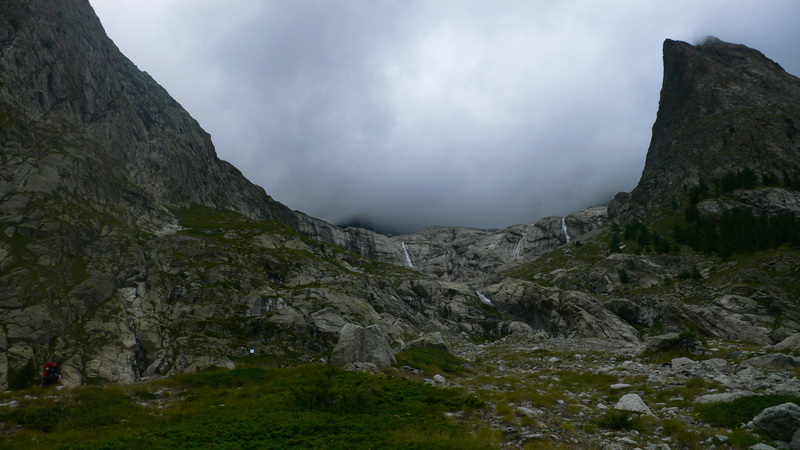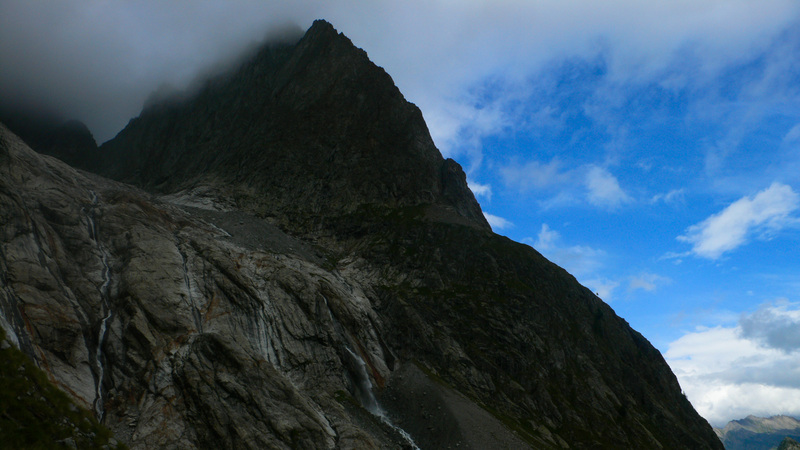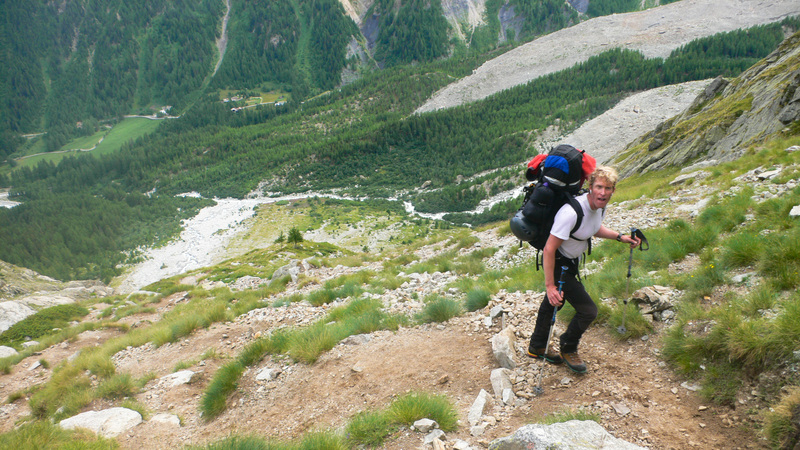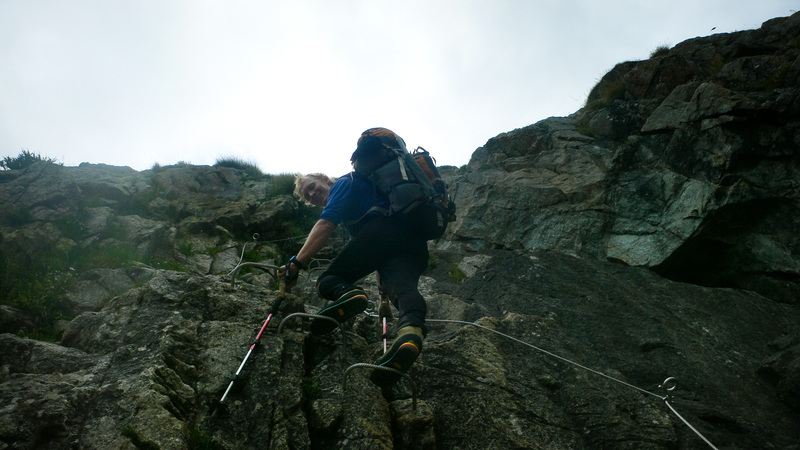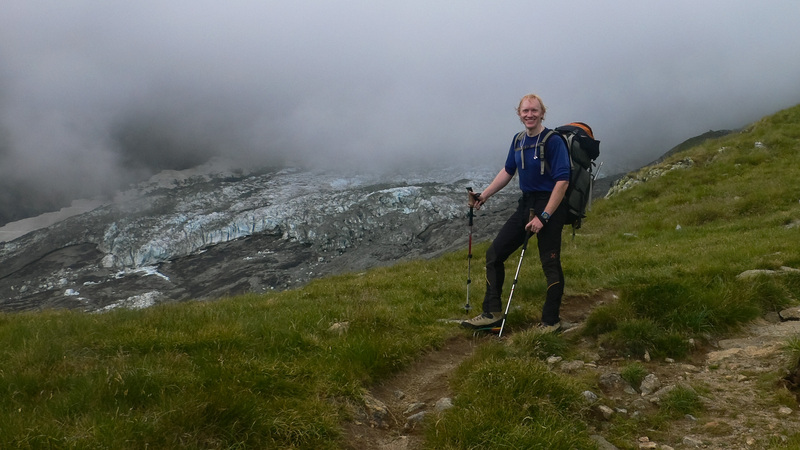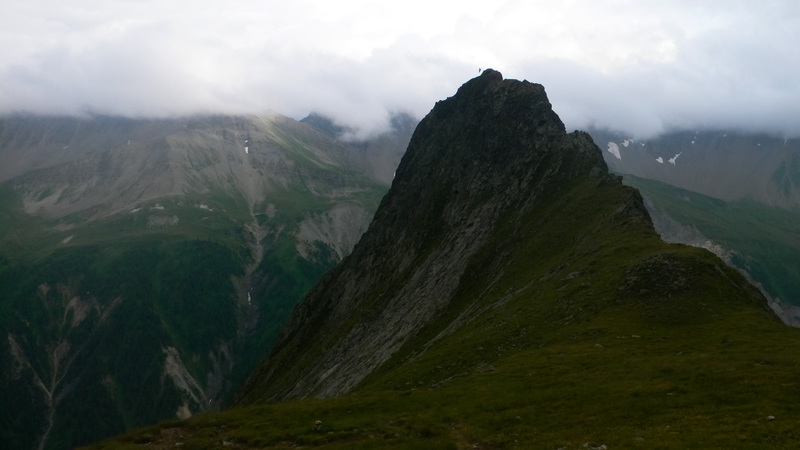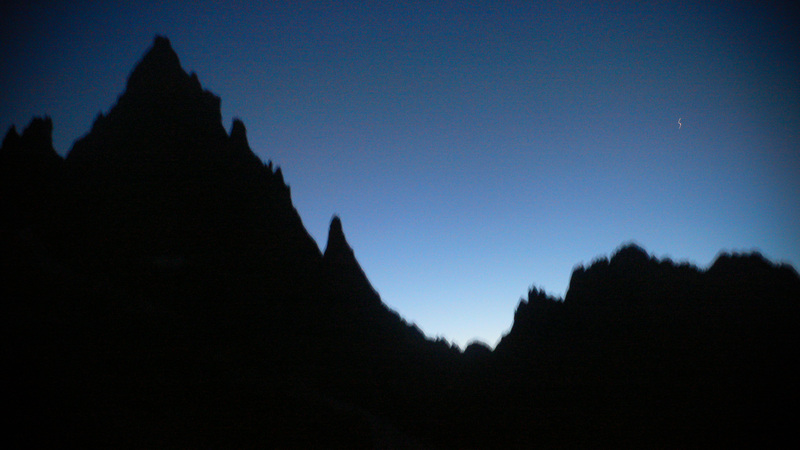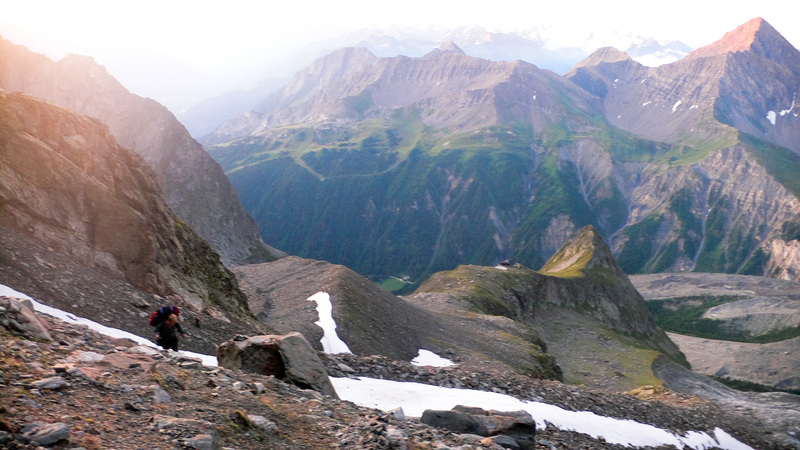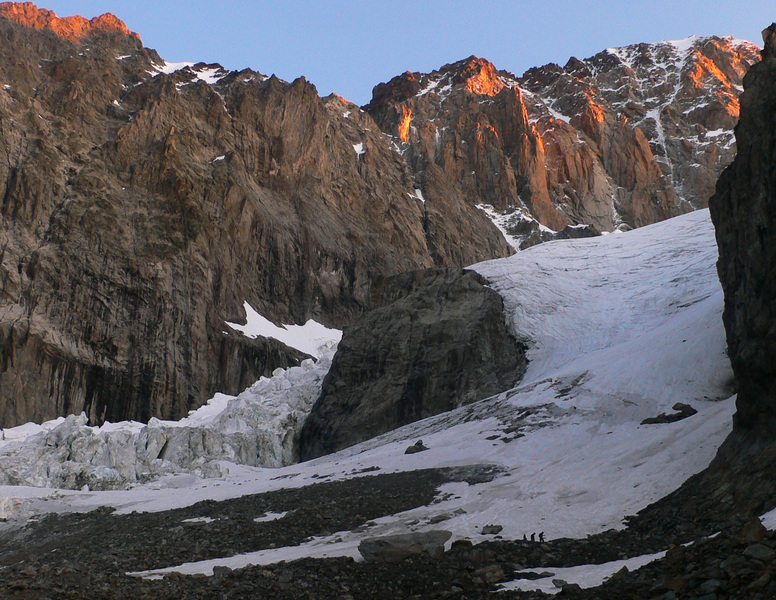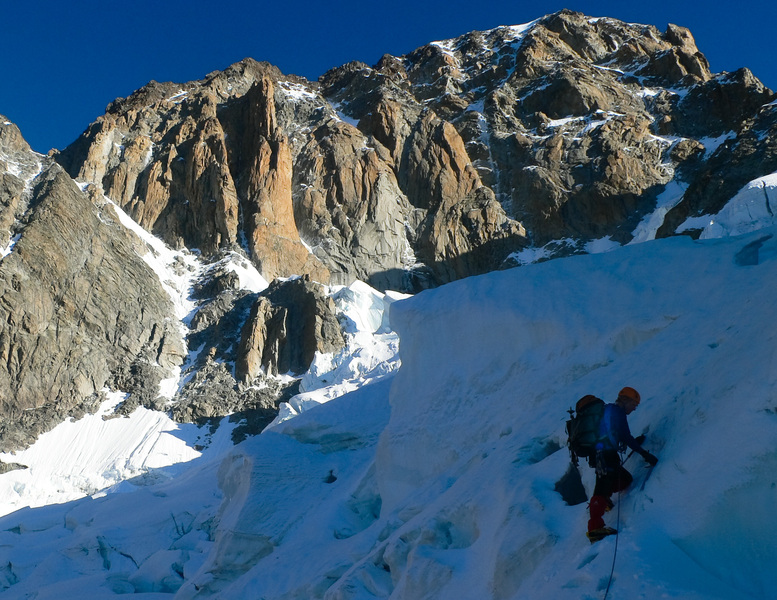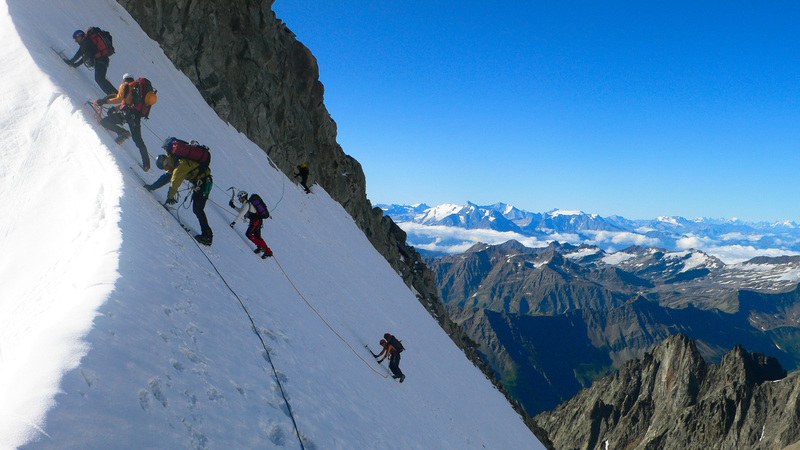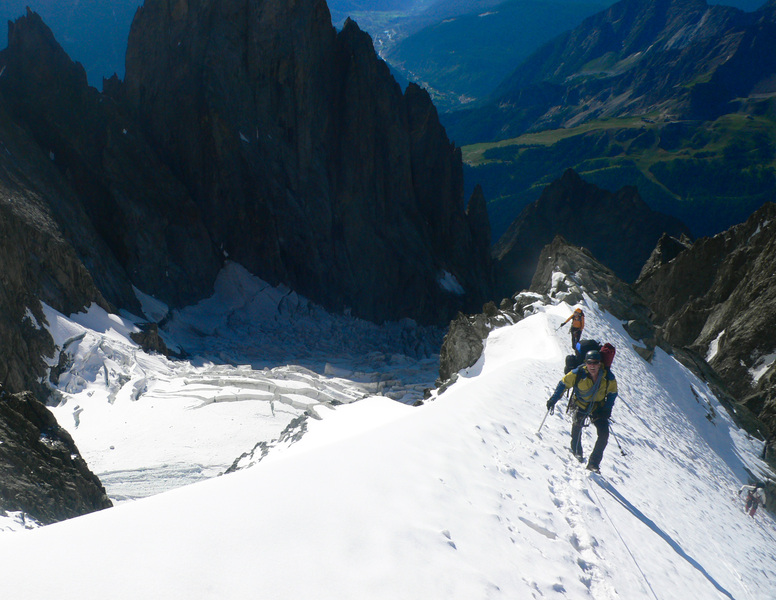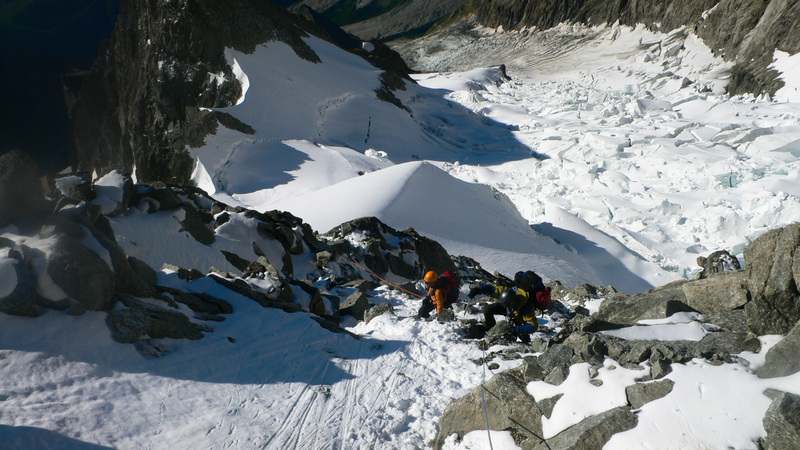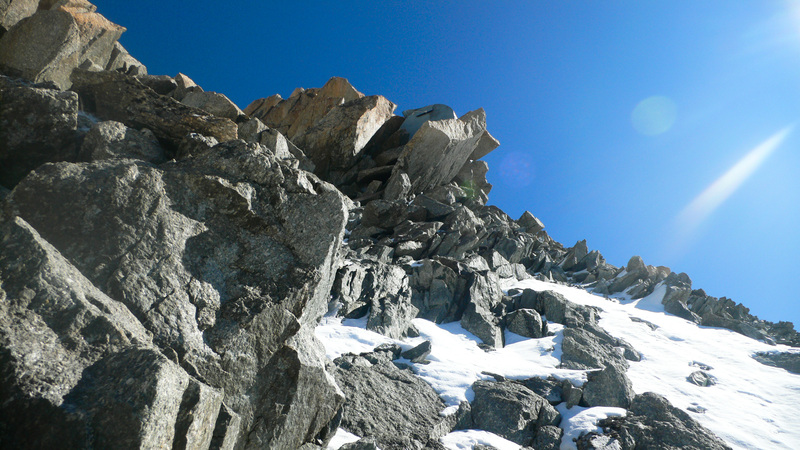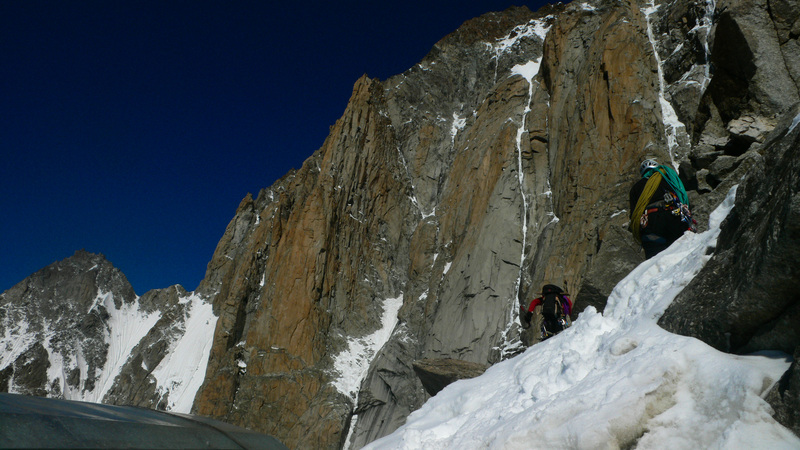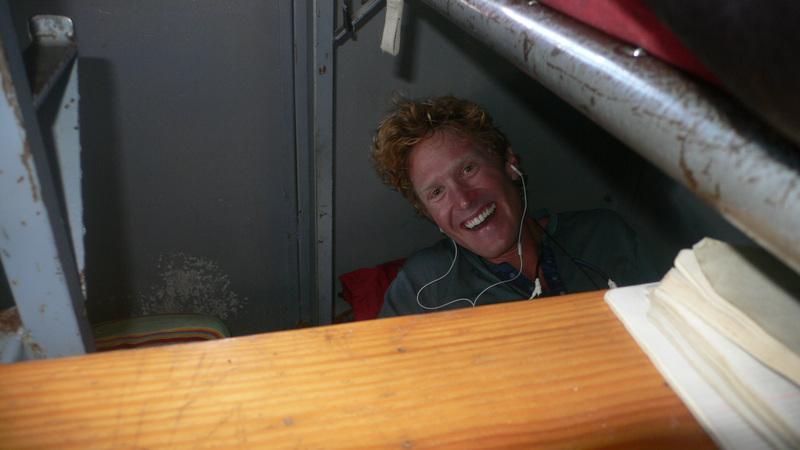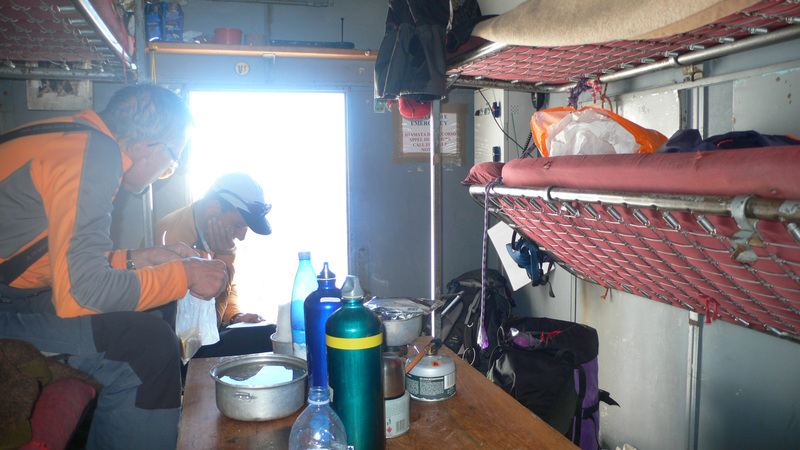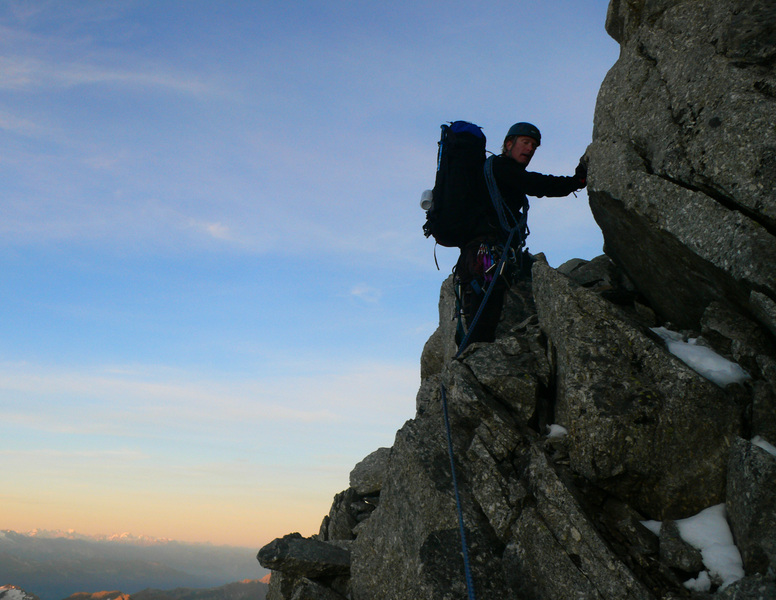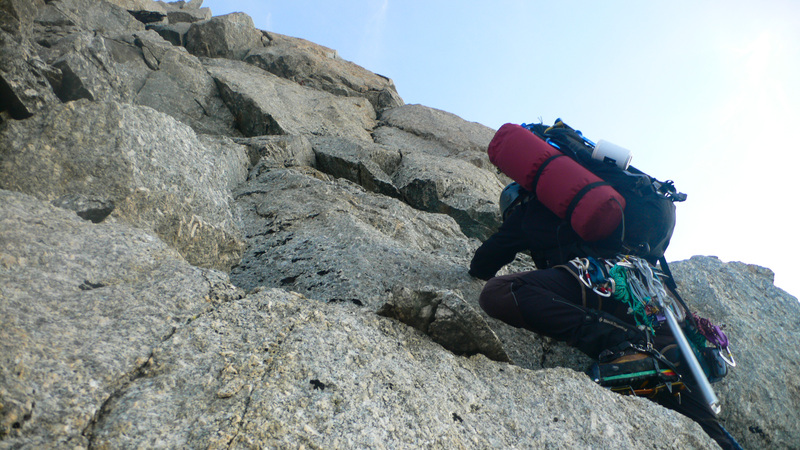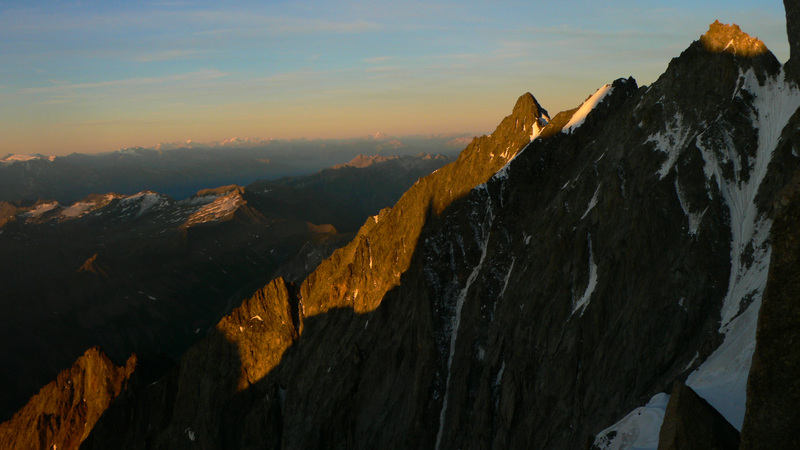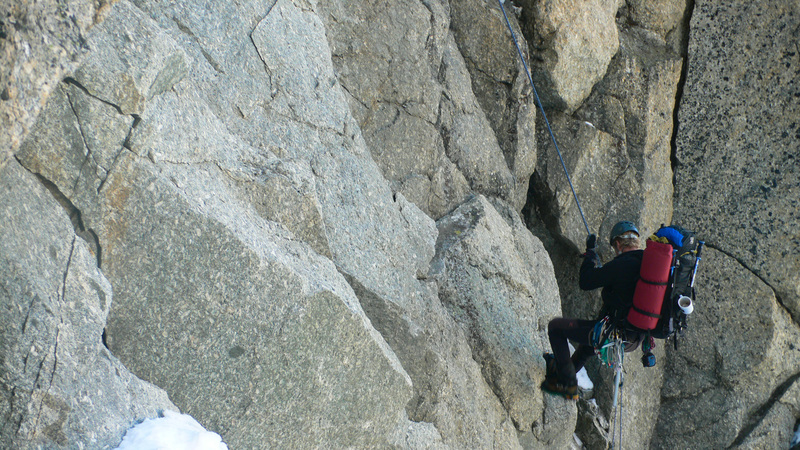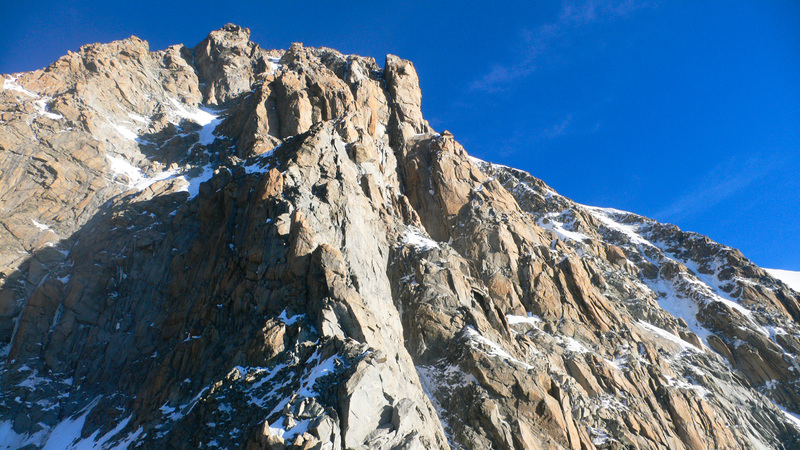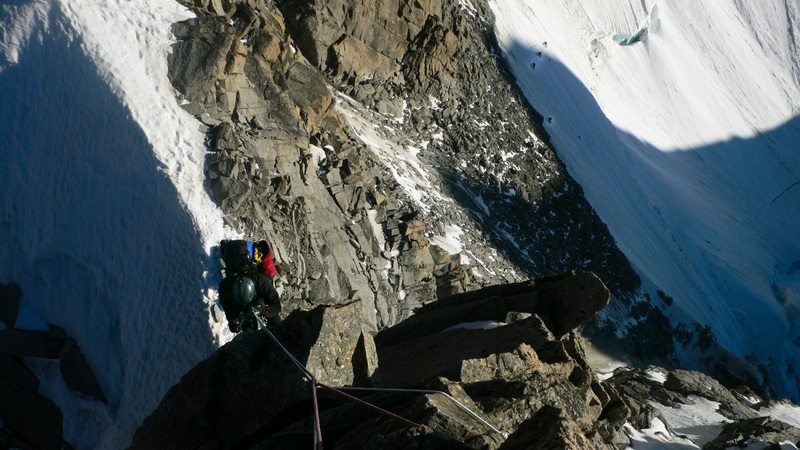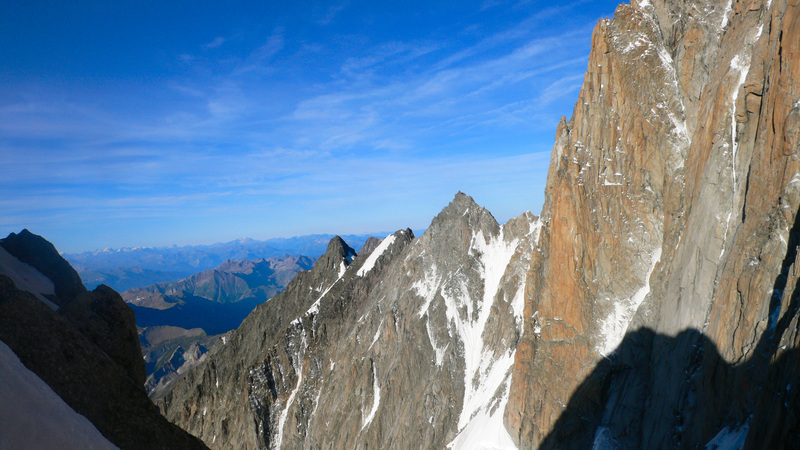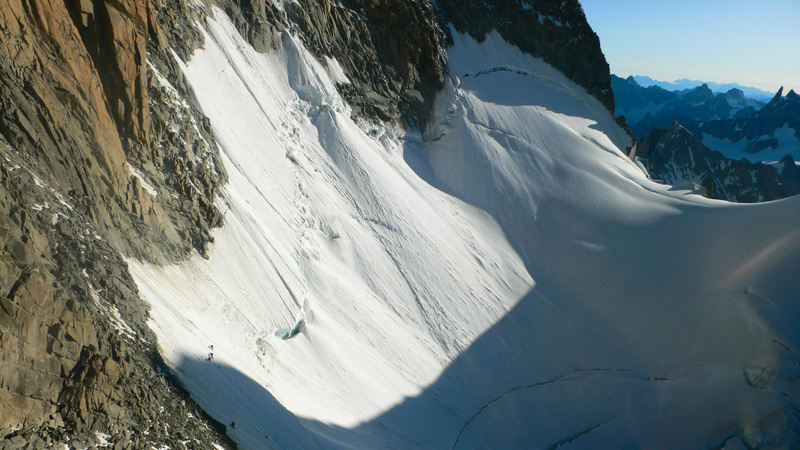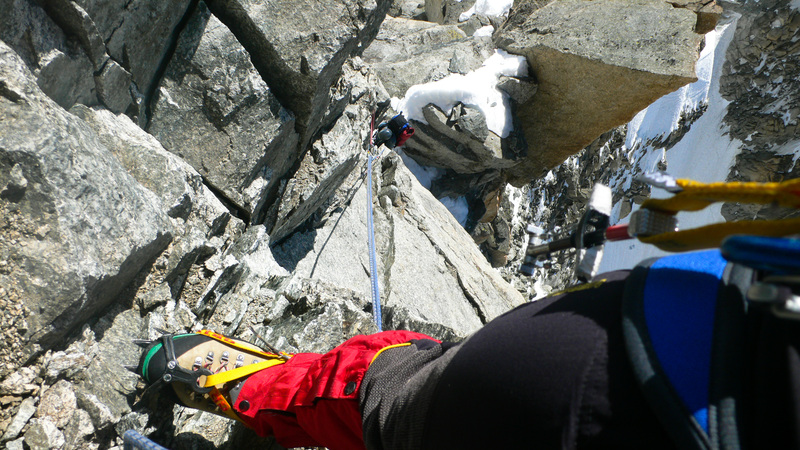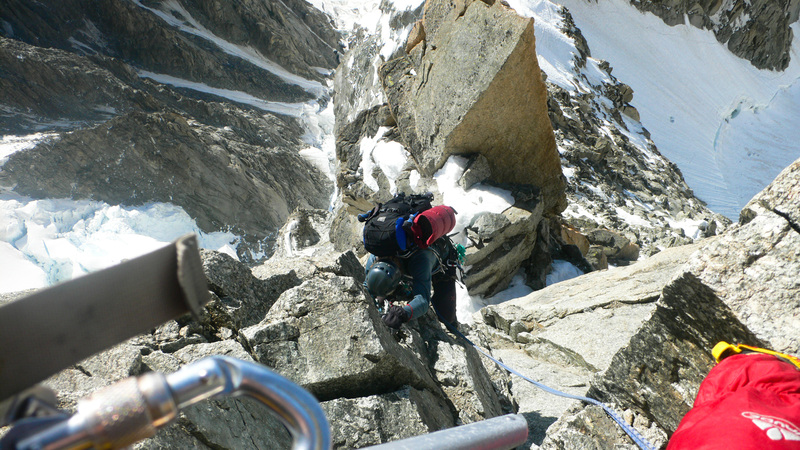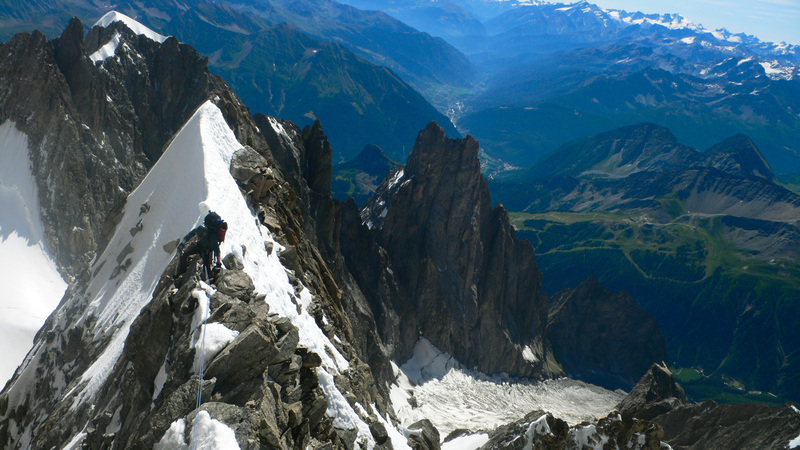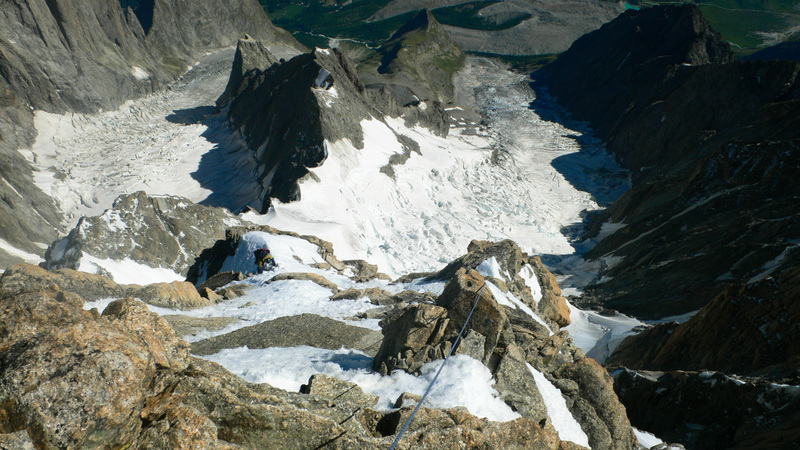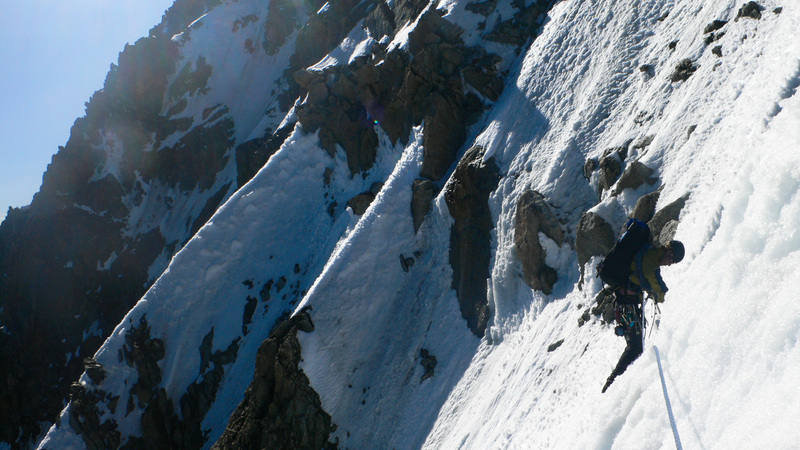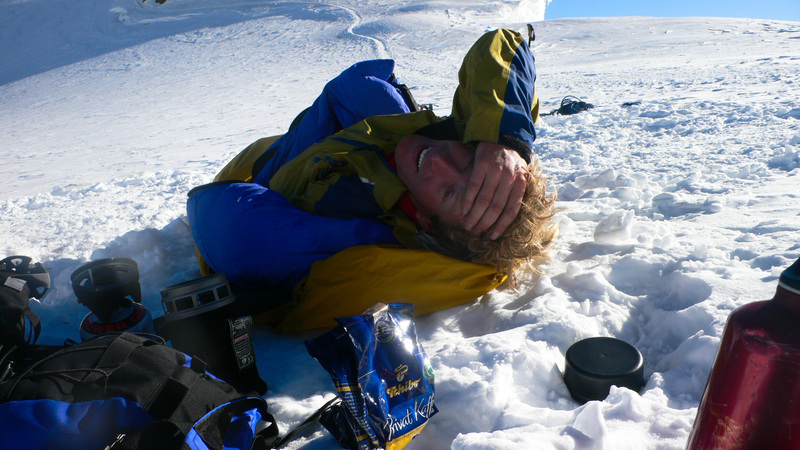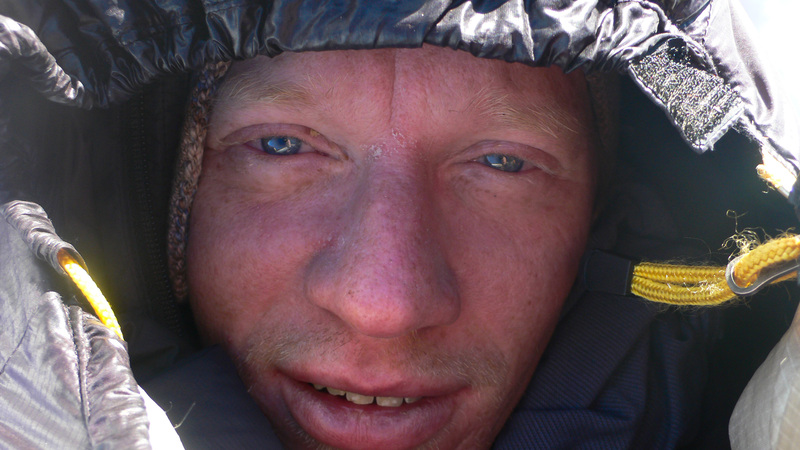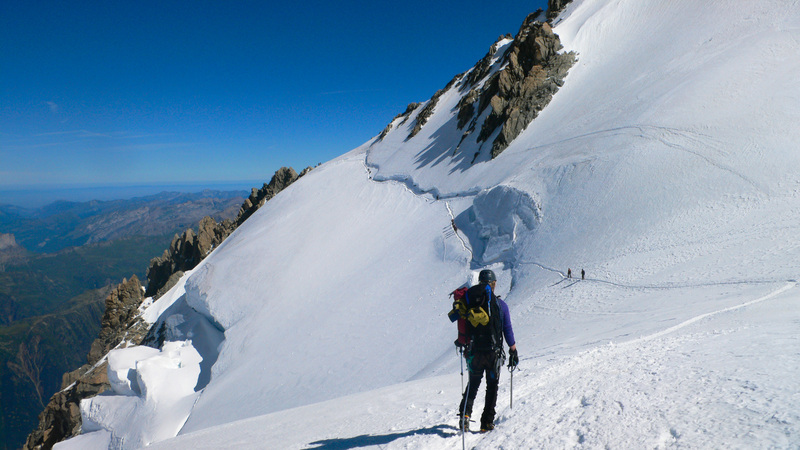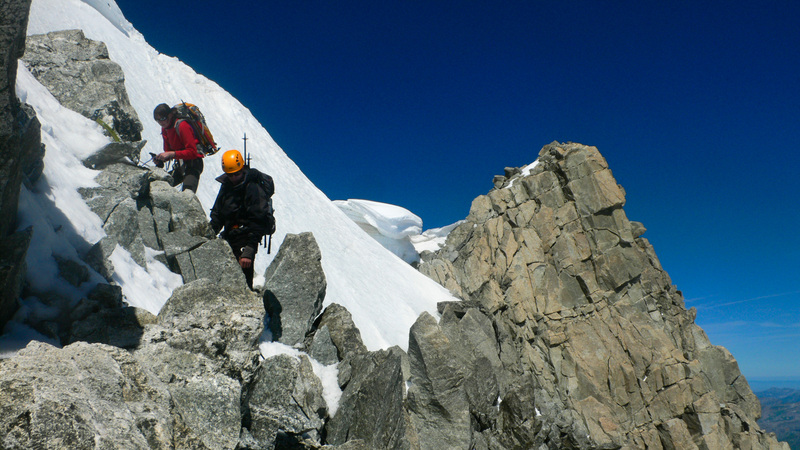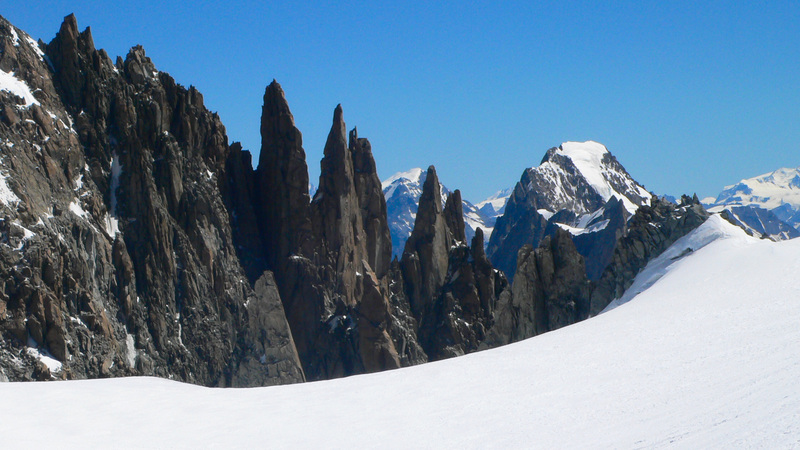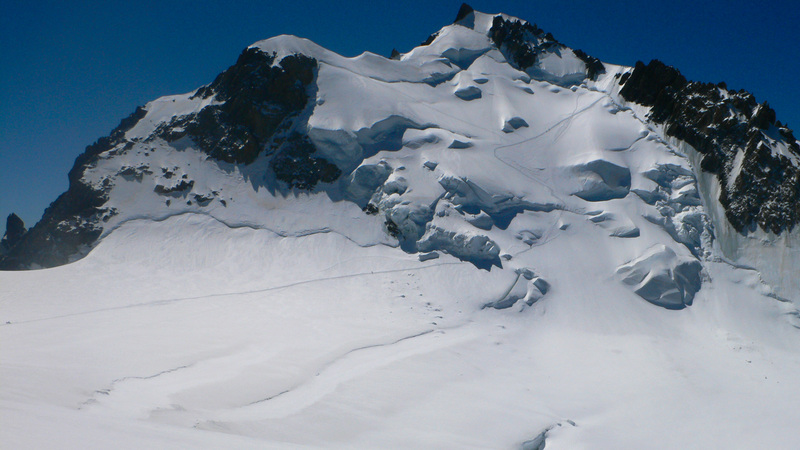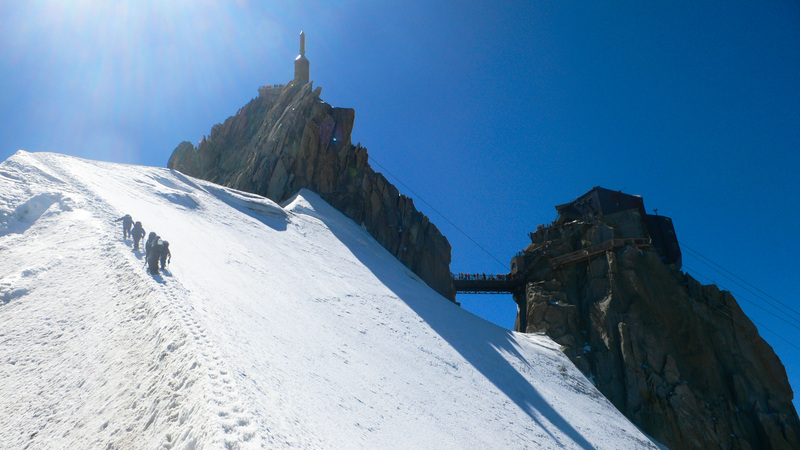Mont Blanc, Innominata Ridge
Friends: DanLocation: Mont Blanc
Elevation gain: 3600m = 3600m
Innominata Ridge, D+
Rahel was in the back of my mind through this whole experience. All the foibles and hi-jinks Dan and I got ourselves into crowded her out, but in still moments she would return. What should I learn from her story, from her life?
Just like the day before Dan and I found ourselves in the common room, lingering over a late breakfast. We were in Argentiere, and should have been out climbing for hours already. But sullen clouds and wet streets kept us in the house. We were starting the second day of enforced idleness, and seemed to be losing our will to move. The forecast kept promising high pressure and it kept retreating in front. "So what's the plan?" asked Dan. "Like I know? But how about Mont Blanc since the rock is wet?"
If we did a big climb of Mont Blanc, we could afford bad weather on the first day as we approached a hut. Dan, veteran of many high-altitude ascents wasn't into a big mountain though. "I've done enough slogging for two lifetimes," he said around a mouthful of Muesli.
I on the other hand, had begun to nurse an obsession to climb Mont Blanc with the most elevation gain possible, somewhat distrusting the validity of an ascent starting from near 4000 meters, as the standard approach from the Aiguille du Midi does. I also wanted to see the fabled golden granite and uplift of the Italian side of the mountain. An ascent by the Innominata or Peuterey Ridges seemed like just the ticket.
"Oh, I would kill for some slogging! Unfortunately, we won't get much of that if we go through the tunnel. It'll be lots of front pointing, dry tooling and crack climbing. Sigh, doesn't sound very attractive."
Dan stopped chewing a moment. I'd laid the hook. Would he bite?
"I don't know. I really wanted to work on rock climbing."
"Me too!" I said, honestly. "But this bad weather may keep going on. At least by going for a big mountain we could be doing something."
My status as a family man leaves little time for moping around hostels, and I was willing to slog through rain, something most of my friends with their vast blocks of leisure time can't understand!
At that moment, Mike and Dave returned from their optimistic attempt to get in position on the Cordier Buttress before the high-pressure crowds went for it. "What a mistake! I'm soaking wet," said Mike.
I owe Mike a big one, because when I mentioned the idea of the Innominata Ridge his eyes widened. "Oh yeah! That's a big route man." Dan was visibly affected by the props the route seemed to warrant. He was ready to talk turkey: "Okay, what do we take?"
"The lightest bivy sacks, pads, sleeping bags we can find. A 50 meter 8 mil rope. 4 cams, 10 nuts, 4 screws. Three ice tools for the two of us. I'll call the Monzino Hut and reserve a place. The next day at the Eccles Hut, and the summit Wednesday. We'll worry about getting down once we do all that. We'll take the sandwiches you made yesterday."
He was in. And we were off, frantically to Chamonix for the 3 pm bus to Courmayeur, weighed down with lots of food. Dan's pack bulged with a winter sleeping bag and pad. It was great to be on the way to something!
In Courmayeur, we caught a bus to Val Veni. I tried to get Dan to listen to my new favorite band, Wintersun, but the screaming and growling rather put him off. I'm a happy person, but sometimes I like dark music. Under somber clouds, going to a dangerous place, it was cathartic to step off the earth in a blast of double bass drums and squealing guitars.
We hiked up a long boulderfield under huge packs, trading air guitar signature riffs because we had the trail to ourselves. The Monzino Hut was 1000 meters above on a lonely ridgecrest. We climbed past waterfalls on trails equipped with metal steps and cable handholds.
We were struck by the beauty of Nicole, the caretaker who showed us our place in a spacious basement room. We didn't learn her name until 2 days later, when 3 Italians caught us sharpening tools at 4 am, momentarily alone in the Eccles bivouac hut. "You call yourself a man and you do not know Nicole?!?" one of them said to me. He then crawled into the bunk I'd just vacated for an hour of sleep before the Pillars of Freney. How would she feel to know that her name travels on the grapevine of shades passing each other in obscure and dangerous places?
But in the meantime, we were happy to have a good dinner in the hut, to talk over ideas of the future with some wine. Possibly inspired by my viking metal soundtrack in the afternoon, I argued that for a climb to be magical one needs to feel the breath of the dragon. 100 percent safe clip ups have their place, but are ultimately forgettable. And so, in this spirit of pomp and high adventure and with the promise of good weather the next day we went to sleep.
Climb Day Minus One
Awake at 4:30 in the Monzino Hut, we went down to the breakfast of tea, bread, cereal, Nutella and coffee that Nicole had prepared for the small group of early risers. Setting off, we hiked up the ridge behind the hut, eventually veering left on indistinct moraine to an abutment of rock that cradled the glacier. With two other parties, we set off, crampons crunching on the granular ice. The great South Face of Mont Blanc was golden- orange above, though we remained in blue shadow.
After a straightforward glacier climb, we reached a slope that had to be climbed and traversed to the left. I started up first, soon discovering that it was truly steep and icy. We didn't place any protection, instead we just promised each other not to fall. It went slowly but steadily to a ridge crest too thin to walk on. But at this point the snow on the face increased enough to hold steps and we had an easy time traversing the ridge to the north. Oddly, four parties all came together at this point, and my photo of the climbing looks like a mob scene with ropes and people everywhere on the icy slope. Another snow slope led to a mixed rock and snow buttress with the lower bivouac hut directly above. We climbed to it, secured two places and settled in. It was 9:30 am, and we'd have a long day to kill until waking up at 3:00 am the next day.
Our hut filled up completely with 9 people. A party of Germans, a French duo, two French guides and ourselves. Dan had to crawl under the table to get to his bunk. I had to walk across the table, dodging boiling pots of water to get to my own. For a while, we sat on the warm roof of the metal box as we melted snow. I went for an exploratory climb to scout the traverse of the glacier to the Col Eccles the next day. Really, you needed crampons and ice axe even to move around the hut. Sometimes I left crampons off, and was completely dependent on holding onto the metal straps that secured the hut in place to keep from falling off. Dan saw a Polish climber at the upper hut rocket down the slope for 20 feet and thankfully slam into a rock big enough to stop him. They exchanged a meaningful look!
I napped, we ate, we went on snow collecting expeditions, having discovered as the day warmed that the fresh snow near the hut overlaid a stinking mound of feces. Feeling queasy, we were glad we'd boiled all the water we got from snow. In general, the hut was an unsanitary island of safety in the midst of dangerous icy walls. Everyone was very friendly, but there was a tension to the place that couldn't be dispelled. We saw many entries in the hut book by the famous French climber Christophe Profit. There was also an entertaining series of entries from American climber John Harlin III. His father had been killed climbing the Eiger North Face. He and his partners brought 10 days of food to the hut and attempted a new route. They eventually completed it, only after days of snowstorms and a second trip up.
Climb Day
Finally, "climb day" came. Everyone else was heading for either the Broulliard Ridge or the Central Pillar of Freney. We let them get up and play with zippers for a few hours as there wasn't room for everyone to be up at once. When they left we ate some oatmeal and readied to go. The nice Italians with Nicole's name came up at this point.
Dan had scouted a way to reach the Col Eccles via glacier slopes, which should save at least an hour versus climbing over Pic Eccles above us. But after a cold and dicey lead, he was only 25 meters out on a steep ice traverse. Calculating the odds, it seemed that we had misjudged the steepness of the glacier traverse, and would have to climb over the peak after all. Depressingly, as we dismantled the belay and started up, the Italians came by. We'd wasted a nap period with our fooling around! Oh well...
From the second bivy hut we followed occasional cairns up to the summit of the Pic Eccles. This was fun scrambling in the dawn. I eventually removed crampons to better enjoy the cracks. Dan kept them on and was just as happy. However we got into a silly argument about this. I characterized his refusal to remove crampons as a robotic nod to fashion, and he portrayed my willingness to change mediums two or three times during a climb as an eagerness to...put them on and take them off every 20 feet or so! Obviously, we were being played by the tension and uncertainty surrounding the climb. It's a strange thing that even as we recognized this we were happy to continue bickering for a while. It took a hard/scary lead to get us to drop the silly argument.
But for now, we made a rappel from near the summit of the Pic Eccles, then a traverse of the mountainside for about 70 meters to reach the north ridge (one long simul-climbing pitch, easy). Finally we could rappel to the Col Eccles. We saw the Italians below, traversing to the Freney Pillars. We also saw there was one party on the Innominata above us, having completed most of the technical pitches already and preparing to cross the Great Couloir. From the col, we scrambled up to the base of the first technical pitch. I removed crampons to lead it: first a grade III chimney, then a short but quite difficult vertical wall (between IV+ and V+ depending on the guidebook you read). I left my pack clipped to a piton, and still struggled mightily on it, landing on the belay ledge like a beached whale. A nest of pitons supported some tattered slings tied into a handhold which I was too proud to pull on. I paid for my pride with an elevated heart rate that seemed permanent!
Dan came up, tied a rope to the pack, and I hand-over-hand hauled it up. "Son of a bitch!" he said about the wide, awkward double cracks. Next Dan traversed a ledge and climbed a delicate bit to a belay on a block in a hole. As Dan disappeared into the hole, he found it was a kind of tunnel that allowed a view into the Great Couloir across from him. So he had front row seats for what came next: a low and massive rumbling filled the air as tons of snow and rocks billowed through the relatively narrow couloir. My view partially blocked, I could only see the debris flying into space where cliffs steepened below the Great Couloir, but the roar was deafening. Doing some mental calculation, I believed the party above us was at least 30 minutes out of the danger zone on the west side of the couloir. But what about us? We had yet to enter it.
I passed through the hole by crawling on a ledge, then headed up a grade III/IV crack system for 35 meters to a belay. This was a very enjoyable rock pitch climbed in crampons and bare hands (the rock was nice and warm). I think this was my favorite part: steep, high enough that the best way off is up, and I felt warm in the sun as I remembered the interesting climbing moves. Only the dangerous crossing to come marred the nice feeling.
The terrain eased, and we simul-climbed a section of easy mixed ground to reach a horizontal snow ridge. Crossing this required three careful 25 meter pitches, as the snow was very delicate and thin. Sometimes I would push my ice axe too aggressively into the snow and create a gaping hole whose thousand-foot drop had a tendency to hold the eye. I've seen many pictures on the web of people standing on top of nice thick ridges of snow on these horizontal ridges. For us, they were paper thin, undercut, and required traversing the sides. Forgive me the use of an overstated rhetorical question...global warming?
On the other side, we planned our strategy to reach the likely point to cross the Great Couloir, for which we now had a healthy respect. I led a long simul-climb on the left side of a large tower up to a sheltered area under a rock. Then, I continued leading further up a short, steep gully with rotten ice in it, eventually reaching a somewhat sheltered belay spot that seemed to be just below the magic elevation of 4250 meters...where we should make the traverse. Dan headed straight up another ice gully to reach a rather frightening open slope in the Great Couloir. He placed an ice screw ("Don't place any more!" I pleaded, not relishing time spent in the exposure zone) then headed left to cross the gully at the narrowest point. He had to climb through a waterfall for a moment too. I followed, pretty nervous about getting hit by rocks or ice, recognizing that there was no safety here.
Still, I filled a quart of water from the stream, then led up a red rock rib, exposed to debris flows. I found a somewhat sheltered spot near the top of the rib, where I could at least see something coming and try to crouch next to a short vertical buttress. Dan led through, finishing the rib, then traversing snow again to reach the base of a gray rock rib. I felt much better on this rib. Looking up at two twisting piles of red rock, I fancied an aura of disappointment that they hadn't been able to ready a new volley of stones for us! Was something holding them back?
Now we simul-climbed the whole gray rib, which was often just a collection of loose stacked blocks. Dan did have a scary moment when a block the size of a small refrigerator came out of the wall when he touched it. It rolled over his leg, giving him a bad bruise at the least. I heard and saw this thing slowly tumble out in front of him. It struck somewhere below. 80 feet above Dan, I could still smell the cordite from the explosion. This was a very creepy moment for Dan! I was very glad that he wasn't badly hurt.
We finished the treacherous gray rib, and scrambled up to a natural belay spot on the right side of an ice couloir that led up and left. I knew we were at the right spot and was happy that we'd successfully traversed the Great Couloir. We finally ate some lunch here, stopping for about 15 minutes, our first such rest of the day. We found a water bottle full of water and unfortunately dirt. I considered drinking it anyway, but Dan warned me about bacteria. Often, I was very thirsty and would eat the snow that was increasingly turning to water in the heat of the day.
Dan climbed what turned out to be the most technical ice pitch in the shady couloir. He placed three ice screws, doing a fine job with just one tool on the 70 degree hard ice. He built a belay up and around the corner. I got out the third tool to follow this pitch, and found I could move quite fast with it.
I continued with a lead up and around another corner to an open slabby area covered in rotten snow. I traversed up and left to try and gain a shallow red buttress that marked the true left side of the Great Couloir. The snow was very challenging, prone to collapse or complete disintegration on unfriendly blank slabs. I eventually learned to stay near the rock for better ice underneath a rotten layer. But if the ice was too thin I'd either venture back into deeper snow or get on the rock itself. I couldn't stay on the rock because climbing smooth slabs in crampons is just too hard. I built a belay and Dan came up (I think this pitch was about 70 meters?). I was using the third tool as well on this pitch, which was helpful.
Dan headed straight up the ridge and found a sling on a block. But steep rock barred the way. He looked left, then further left and down, and then further left and down before finding a way around the steep rock. It was a frustrating experience, because by the end of the pitch he'd spent a lot of time downclimbing difficult snow only to come back very close to my own position. We didn't keep track of the time, what was the use? But it felt like it was late afternoon by this point, as shadows had begun to re-invade the face on a western rock boundary.
I followed to this point, then headed up a mixed snow/rock series of gullies and steps back to the buttress crest. Simul-climbing, I eventually reached a steep area where my passage ended up destroying all the ice on the rocks. I stuck my ice pick into a crack and used it as a handhold to make a delicate traverse around a corner and reach a large block I could sling and belay Dan from.
From here, Dan headed out on a monster 200 meter "pitch", leading up some rock at first then continuous snow and ice. He had his ice ax and the third tool. Gear was extremely sparse. At one point, in deep snow, he left his ice axe buried and tied-off. We had four ice screws, and I believe he placed them all, each one about 50 meters apart such that we always had one (and only one) piece of protection between us. Purely psychological protection for us both! Sometimes it was good kick-stepping snow which felt very secure, and other times hard ice with a thin layer of snow on top.
It was a great effort, exactly the kind of long push moving together we needed to get off the steep ground. But it took considerable trust. We'd both been in the rotten snow enough to have learned it's tricks. Since Dan left one of the axes as "pro," I could continue with two axes, taking special care to move one limb at a time, offering him a margin of additional psychological security by noting how secure my placements were (at least that was my intent, I probably just annoyed him with my occasional braying about the solid snow).
Near the end, hard ice under snow put us back on guard, but then Dan reached the crest. We had climbed the face! All of the real difficulties were below us!
Naturally I picked this moment to drop my ice ax down the face. "Oh no!" I said cartoonishly. "Oh no!" echoed Dan.
Through the hours I always had my leash on, and had grown used to "dropping" my axe to grip rock. But this time, reaching for a rock, I had no leash on. Groan. At least I still had the short third tool.
Tiredly, we shortened the rope to about 10 feet between us, and followed the ridge up and down slowly to the Courmayeur summit of Mont Blanc. Exhausted, we trudged in tracks to the summit of Mont Blanc, arriving exactly at sunset. Weak pink light from a low orange sun bathed the simple, broad horizontal ridge that makes up the summit. We were all alone. It was quite beautiful, though I wished we weren't so high at this late hour.
I was too tired to take pictures, though I'll never forget the scene.
Somewhat abruptly, I felt nausea and a throbbing headache. Dan deduced I was getting acute mountain sickness, and took over, leading us down the easy snow path northeast as quickly as possible. The moon was out and it was clear so we didn't bother with headlamps. The wind was icy cold, and we started wishing for a sheltered place to throw down our bivy sacks and sleep. We investigated some rocks, but they were useless (though they stank). Later, at the Brenva Col we saw a tent (which we thought was a rock). Immediately we decided to camp nearby, hoping the tent would provide some wind shelter. It didn't, but we stopped anyway.
I crawled into my sleeping bag and alternated between shivering and passing out exhausted. Dan tended the stove and forced me to eat a little something. Later, he made tea, which I should have also drank but I was out cold and he couldn't wake me up. It was probably about 11 pm at this point, after being on the go since 4:00 in the morning. The night was extremely miserable and I shivered continuously. I wiggled my toes and fingers for hours to keep them from freezing. Dan had selflessly given me his thick down belay jacket when we bivied, and this must have helped tremendously to supplement my inadequate "summer bag." I stuffed my boots and hardware into the bivy sack to keep them from freezing. Dan's bag was much better, and he had a full-length Thermarest so that his feet could (in theory) be warmer. Still, he was cold too and did his share of shivering. At one point he said I was moaning and shivering loudly, which creeped him out! I do remember counting to 420 as I did abdominal crunches, trying to get to 600. I think that warmed me up enough that I got about 20 minutes of sleep out of it. We were each attacked by a violent calf cramp at some point, I remember moaning and almost screaming about it. The poor people in the tent! (though I heard snoring from there so I guess they didn't mind).
Now, this was a bivy on a clear, fine night in high summer, not especially cold by Mont Blanc standards. We were uncomfortable, but we weren't in danger. I can't imagine if we had been in a real storm.
Eventually, Mont Blanc climbers on the normal route started walking by. We heard them comment about us laying there in our "coffin sacks" in three or four different languages. Now we knew we just had to wait for the sun and we would be okay. Hours later it appeared and I slept like a tired lamb for a couple of hours.
After some oatmeal and tea we slowly got on the move (around 11 am), following the pounded in track across glaciers to reach the Aiguille du Midi. Uphill sections were extremely slow...we were like old men (especially me). We had to get down a steep snow/ice slope near Mount Maudit. Dan climbed down on belay, reaching some slings around a horn of rock. Worrying about the unprotected down-climb distracted me enough to leave my ski pole at the top of the steep slope! We made a 25 meter rappel from the slings, then down-climbed with the aid of a fixed line another 25 meters to the base of the slope. At that point I realized I'd left my pole.
There was no way I would go back up, and the several other climbers "bottlenecked" at this point were coming down much more slowly, and I didn't want to wait an hour for someone to bring it down to me. Good bye pole! Keep my axe company!
A beautiful journey down steep glaciers of Mount Maudit brought us to another pass, then a long uphill walk to round a shoulder of the massive Mont Blanc du Tacul. Around the corner we finally saw the Aiguille du Midi, and descended the glacier fairly quickly. A final "heartbreaking" climb of about 800 feet got us to the lift station. Here we suffered culture shock at seeing all the nicely dressed, amply-fed tourists in t- shirts. It seemed almost unseemly to be so comfortable.
Down in hot Chamonix we wolfed down omelettes, cake, bread and olive oil. I seriously considered asking a little girl if I could have her pizza that she had just nibbled the corners of, but I feared the wrath of the waiters.
For the next day, we would either stare dumbly at things or erupt in psychotic laughter as we remembered some particularly ridiculous situation we'd found ourselves in. For some reason, lying there shivering deliriously had become hysterically funny. If you have to laugh or cry, I guess it's better to laugh.
Rahel
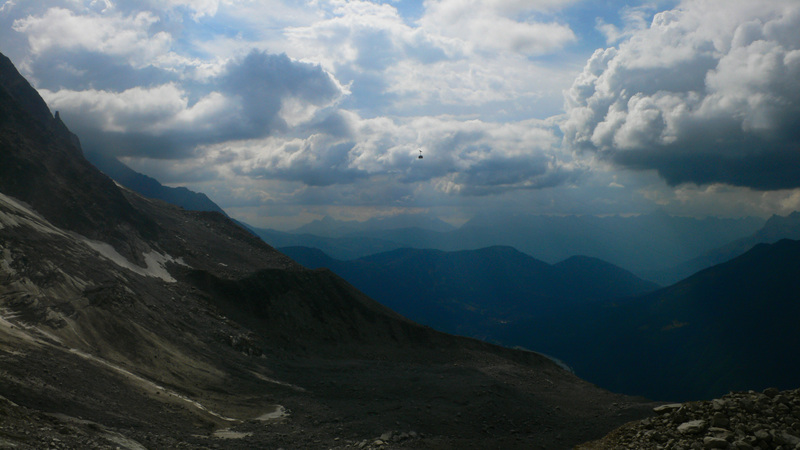
The cable car brings everyone safely down from the Aiguille du Midi
 I thought a lot about Rahel on this climb, and still do. I never knew her,
but it's wonderful to browse her web pages and see
her love of music, philosophy and mountains.
Her mother, Hiltrud, has been an amazing presence here on Summitpost, reminding us
all that we have loved ones, but allowing us to celebrate the wild rock and snow too, as Rahel did. I think she lived a deep and rich life.
Though she was taken too soon, she remains a beacon of light:
I thought a lot about Rahel on this climb, and still do. I never knew her,
but it's wonderful to browse her web pages and see
her love of music, philosophy and mountains.
Her mother, Hiltrud, has been an amazing presence here on Summitpost, reminding us
all that we have loved ones, but allowing us to celebrate the wild rock and snow too, as Rahel did. I think she lived a deep and rich life.
Though she was taken too soon, she remains a beacon of light:
"No coward soul is mine, No trembler in the worlds storm-troubled sphere: I see Heavens glories shine, And faith shines equal, arming me from fear." -- Emily Brontë
Rock and snow pound down mercilessly, by chance or something more. Sometimes they remain in place. Held by a breath, by a hand, graceful but strong. It takes understanding to show mercy. Who put these thoughts on the air, and who made it still?
